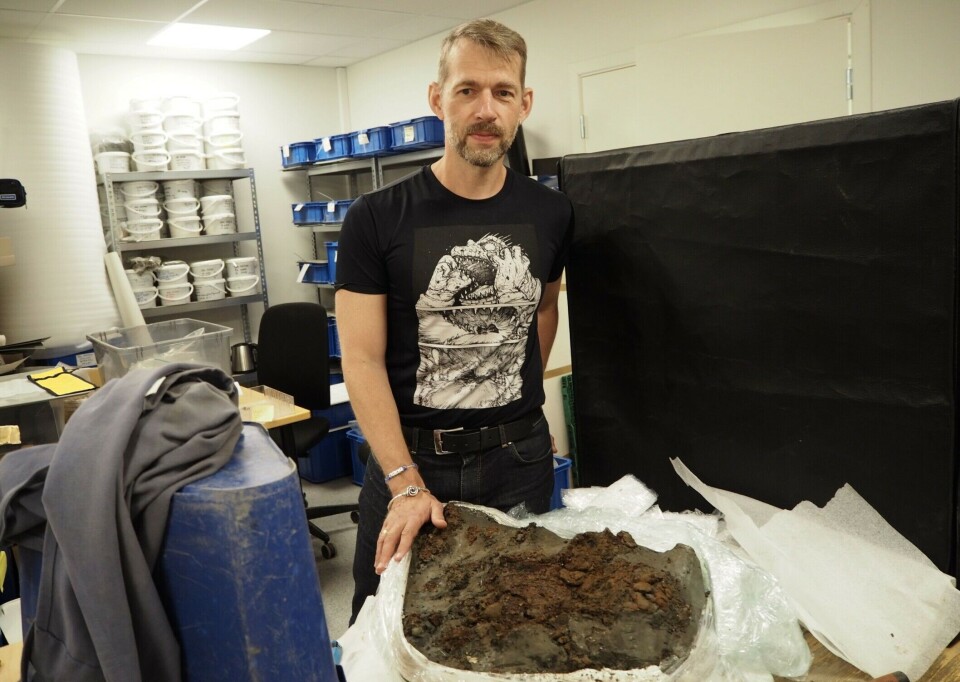
Remarkable find: Archaeologists in Norway discovered the remains of a gauntlet on the seabed
What is this precious steel glove doing in the sea?
Since 2019, the Norwegian Institute for Cultural Heritage Research (NIKU) has been excavating in Bispevika, Oslo. The area has never been investigated by archaeologists before, making the discoveries special.
Before 1624, the area was part of Oslo harbour.
Now, archaeologists have found the remains of a gauntlet in this area. It's not just any gauntlet, but one made of iron. It’s from the Middle Ages and is very rare.

Expensive lost property
“In the 1500s, during the Renaissance, we find nails everywhere in the city. In the Middle Ages, it seems that iron was reused and reforged, so you find almost no remains of it in the city,” says Håvard Hegdal.
He is an archaeologist at NIKU and the excavation's project manager. He says this discovery is special.
“The gauntlet would never have been left lying in the streets in medieval Oslo. This is an extremely expensive object. An ordinary person would never own something like this. The only way you can find things like this is if they’re buried or lost in some way. On the seabed, no one could have gotten hold of it,” he says.

What triggered the metal detector was just a small part of the gauntlet. Most of what remains is an imprint, where you can see remnants of iron plates or lamellae. The imprint is so clear that Hegdal concludes it must be a gauntlet.
Customs control
This is not the first discovery of weapons and war artefacts made in the harbour.
Hegdal believes there might have been customs controls in the harbour.
“Weapons confiscations have happened in other parts of Europe. Customs officers have thrown weapons into the sea or even destroyed weapons over a certain length,” he says.
Due to the quantity of finds, Hegdal does not believe the weapons ended up on the seabed in the harbour by chance.
“We’ve found many daggers, as well as swords and axes. Clearly, these are not things people simply lose. Finding so many weapons in the harbour suggests it was systematic. There must be a reason they ended up on the seabed,” he says.
More discoveries
Archaeologists have made several finds at the bottom of the fjord. Some items have held up well, while others have succumbed to the ravages of time.
“All the iron is completely destroyed, leaving only fossils. The only thing that triggered the metal detector on that sword was a large bronze pommel. It was beautiful. The rest of the sword was just a rust imprint,” he says.
The archaeologists have also found more macabre discoveries in their excavation.

“A truly strange object we’ve found is a human arm. An upper arm bone, gnawed by dogs. Whether it was dragged down from the execution site at Galgeberg and ended up on the ice, or something else, we don’t know,” he says.
Only hypotheses
It is difficult to find out more about the origin of the gauntlet and how it ended up in the water.
“One hypothesis is that it might have something to do with customs. War equipment could fit into a pattern of weapons and long knives being thrown into the sea. But we don't know any more than that,” says Hegdal.
With limited documentation from the Middle Ages in Norway, it is difficult for archaeologists to form a clear picture of what might have happened.
“Many Norwegian medieval documents burned in Copenhagen in the 1700s. The city law for Oslo is not preserved. We haven’t even found any regulations or documentation indicating that items were thrown into the sea. We only have all the weapons we've found out there,” he says.
Well preserved
Archaeologists have to work a little differently when excavating areas that have been underwater.
The fact that things have been lying on the seabed is actually an advantage.
“On the seabed, everything just stays put; it doesn’t get crushed, kicked around, or reused. Furthermore, most items lie in neat layers on top of each other. When we date things, we often have clear strata to follow,” says Hegdal.

The layers have built up from centuries of mud and waste, lying undisturbed. It’s not like that on land.
“In the city, it’s different. People have dug and shovelled, stacked things on top of each other, and built houses over the ruins of older houses that have been pressed down. It's total chaos,” he says.
Few answers
How the glove ended up in the sea remains a mystery.
“I find it very difficult to imagine someone losing their gauntlet during a battle. If there had been an arm in it, it would have been much more interesting, but there wasn't,” he says.
Hegdal also does not believe they will find anything more to explain the discovery.
“If there had been anything else related to the gauntlet, we would’ve already found it. It’s an archaeologist's dream to find remains of some of the battles that took place out there in the fjord, but we haven’t. So the best explanation we have so far is simply that someone lost it. You could call that bad luck,” he says.
———
Translated by Alette Bjordal Gjellesvik
Read the Norwegian version of this article on forskning.no
Reference:
You can read more about the excavation in Bispevika on NIKU’s website (link in Norwegian)





































